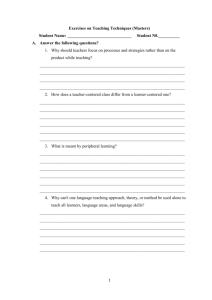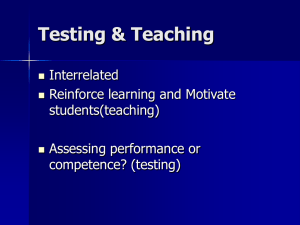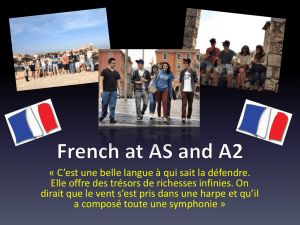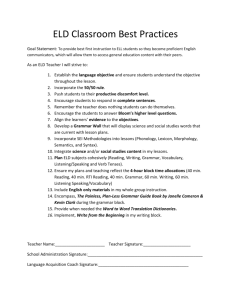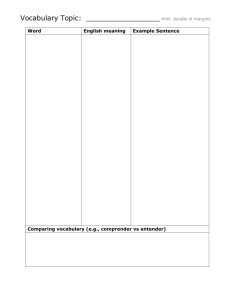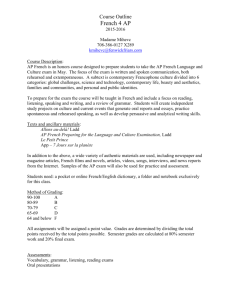SYLLABUS INGLES III - audio
advertisement
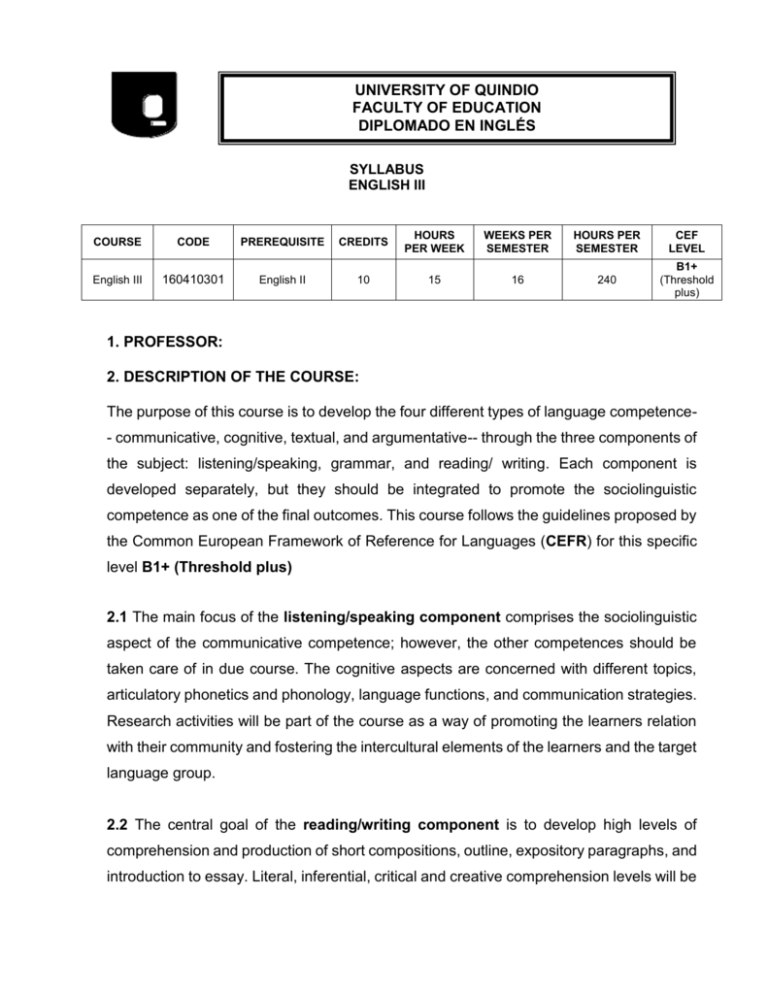
UNIVERSITY OF QUINDIO FACULTY OF EDUCATION DIPLOMADO EN INGLÉS SYLLABUS ENGLISH III COURSE CODE PREREQUISITE CREDITS HOURS PER WEEK WEEKS PER SEMESTER HOURS PER SEMESTER CEF LEVEL English III 160410301 English II 10 15 16 240 B1+ (Threshold plus) 1. PROFESSOR: 2. DESCRIPTION OF THE COURSE: The purpose of this course is to develop the four different types of language competence- communicative, cognitive, textual, and argumentative-- through the three components of the subject: listening/speaking, grammar, and reading/ writing. Each component is developed separately, but they should be integrated to promote the sociolinguistic competence as one of the final outcomes. This course follows the guidelines proposed by the Common European Framework of Reference for Languages (CEFR) for this specific level B1+ (Threshold plus) 2.1 The main focus of the listening/speaking component comprises the sociolinguistic aspect of the communicative competence; however, the other competences should be taken care of in due course. The cognitive aspects are concerned with different topics, articulatory phonetics and phonology, language functions, and communication strategies. Research activities will be part of the course as a way of promoting the learners relation with their community and fostering the intercultural elements of the learners and the target language group. 2.2 The central goal of the reading/writing component is to develop high levels of comprehension and production of short compositions, outline, expository paragraphs, and introduction to essay. Literal, inferential, critical and creative comprehension levels will be aimed at. The components of the communicative competence to be developed are the sociolinguistic, the discursive, the linguistic, and the strategic ones. 2.3 The grammar component of the course corresponds to the study of some of the linguistic elements of the language. Grammar should be taught in context and envisaged as part of language functions in order to develop speech acts at the communicative level. 3. OBJECTIVES OF THE COURSE: 3.1 General Objective: To develop the basic communicative, cognitive and textual competences through the three main components that constitute the course. 3.2 Specific Objectives: To develop fluency and accuracy in English. To read and write short compositions, outlines, expository paragraphs and introductions to essays. To be aware of the grammatical aspects of the language and use them in contextualized situations. 4. METHODOLOGY This course responds to the present requirements of a foreign language teaching methodology, which is perceived as an important tool in the current communicative environment. In addition, it encompasses other abilities that go beyond the simple commitment of accomplishing the linguistic needs. For this reason, this course is based on the Action Method which focuses on the development of a set of skills that lead to the acquisition of tools to enable communication in real life situations. During this course, the 2 speech acts are carried out through linguistic activities that are included in the social context and contribute to the meaningful learning process of the students. 5. CONTENTS 3 COMMON EUROPEAN FRAMEWORK OF REFERENCE Goals to achieve by the end ofThird Semester Independent User: B1 + (Threshold plus) Language Skill General competence GRAMMAR WRITING Specific Competences Content Can describe experiences and events, dreams, hopes & ambitions and briefly give reasons and explanations for opinions and plans. Can give straightforward descriptions on a variety of familiar subjects within his/her field of interest. Can reasonably fluently relate a straightforward narrative or description as a linear sequence of points. Can give detailed accounts of experiences, describing feelings and reactions. Can describe events, real or imagined. Can briefly give reasons and explanations for opinions, plans and actions. Review of Continuous tenses (Past and Future) Review of perfect tense (Past and Present) Future Perfect Perfect progressive tenses (past present future) Adjective and Noun clauses Second and Third conditional Passive/Active Voice Pattern verbs (Adj+Noun+Prep) Phrasal Verbs (Two and Three word verbs) Gerunds/Infinitives The use of “Get-Wish” Reported Speech Michigan Practice I Can produce simple connected text on topics which are familiar or of personal interest. Can write straightforward connected texts on a range of familiar subjects within his field of interest, by linking a series of shorter discrete elements into a linear sequence. Can write straightforward, detailed descriptions on a range of familiar subjects within his/her field of interest. The writing process-Outline The rules of punctuationoutline within the paragraph structure Expository paragraph: definition paragraph, Basic APA rules Expository paragraph: process paragraph (how to) Expository paragraph: process paragraph (explanatory) Suggested underlying topics* Sports Technology Health Culture Entertainment Environmental Issues Final project: Science Fair *The topics suggested in this section should be specified, adapted and contextualized according to students’ historical and cultural context. Can write accounts of experiences, describing feelings and reactions in simple connected text. Can write a description of an event, a recent trip – real or imagined. Can write short, simple essays on topics of interest. Can summarize report and give his/her opinion about accumulated factual information on familiar routine and non-routine matters within his/her field with some confidence. Can write very brief reports to a standard conventionalized format, which pass on routine factual information and state reasons for actions. READING Can understand the main points of clear formal and informal input on familiar matters regularly encountered in work, school, leisure, etc. Can understand straightforward factual information about common everyday or job related topics, identifying both general messages and specific details […] Can understand simple technical information, such as operating instructions for everyday equipment. Can follow detailed directions. Can read straightforward factual texts on subjects related to his/her field and interest with a satisfactory level of comprehension. Can understand the description of events, feelings and wishes in personal letters well enough to correspond regularly with a pen friend. Can scan longer texts in order to locate desired information, and gather information from different 5 Expository paragraph: comparison and contrast Persuasive paragraph Argumentative paragraph Composition Introduction to essay Parallel Structure Reading comprehension based on author’s purpose, topic, genre and format. Predicting Deducing/Inferring Skimming/Scanning Contextual clues Identifying markers of coherence and cohesion Sports Technology Health Culture Entertainment Environmental Issues Final project: Science Fair LISTENING Can deal with situations likely to arise whilst travelling in an area where the language is spoken. parts of a text, or from different texts in order to fulfill a specific task. Can find and understand relevant information in everyday material, such as letters, brochures and short official documents. Can identify the main conclusions in clearly signaled argumentative texts. Can recognize the line of argument in the treatment of the issue presented, though not necessarily in detail. Can recognize significant points in straightforward newspaper articles on familiar subjects. Can generally follow the main points of extended discussion around him/her, provided speech is clearly articulated in standard dialect. Can follow a lecture or talk within his/her own field, provided the subject matter is familiar and the presentation straightforward and clearly structured. Can follow in outline straightforward short talks on familiar topics provided these are delivered in clearly articulated standard speech. Can understand the information content of the majority of recorded or broadcast audio material on topics of personal interest delivered in clear standard speech. Can understand the main points of radio news bulletins and simpler recorded material about familiar subjects delivered relatively slowly and clearly. 6 *The topics suggested in this section should be specified, adapted and contextualized according to students’ historical and cultural context. Identifying Reporting Expressing agreement and disagreement Expressing pleasure and likes Expressing dislikes Expressing preference Using compensatory strategies Cohesion and coherence in oral speech Raising cultural awareness Supra segmental features Sports Technology Health Culture Entertainment Environmental Issues Final project: Science Fair SPEAKING Can deal with situations likely to arise whilst travelling in an area where the language is spoken. Can generally follow the main points of extended discussion around him/her, provided speech is clearly articulated in standard dialect. Can reasonably fluently sustain a straightforward description of one of a variety of subjects within his/her field of interest, presenting it as a linear sequence of points. Can reasonably fluently relate a straightforward narrative or description as a linear sequence of points. Can relate details of unpredictable occurrences, e.g. an accident Can relate the plot of a book or film and describe his/her reactions Can describe events, real or imagined. Can develop an argument well enough to be followed without difficulty most of the time. 7 Identifying Reporting Expressing agreement and disagreement Expressing pleasure and likes Expressing dislikes Expressing preference Using compensatory strategies Cohesion and coherence in oral speech Raising cultural awareness Supra segmental features *The topics suggested in this section should be specified, adapted and contextualized according to students’ historical and cultural context. 6. ASSESSMENT AND EVALUATION For each component, assessment will be carried out both in formative and summative ways. The fifty percent of all the grades will be based on a follow-up procedure and the other fifty percent on the mid-term (25%) and final examination (25%). The final grade of the course will be obtained taking into account that the grade for the listening and speaking component corresponds to the40%, for the reading and writing component corresponds to 40%, and for the grammar component corresponds to the 20%. Follow-up 50% Activities Mid-term examination 25% Final Examination 25% LISTENING/SPEAKING Presentations, role-plays, listening tasks, participation in discussions, round tables, listening quizzes, phonetic exercises. Listening Exam Listening Exam Oral exam Oral exam GRAMMAR Presentations, role plays, grammar analysis, class activities, quizzes, grammar tasks. Mid-term Final exam READING/WRITING Paragraphs, reading comprehension tasks, books, quizzes Mid-term Final Criteria Grammar Component Reading/Writing Component Listening/Speaking Component Total Percentages 20% 40% 40% 100% Important Notice: A student who fails any of the three components of the course (Listening/speaking, grammar, or reading/writing) will have to take the course (English III) again. There is no re-examination for this course. 7. INDEPENDENT WORK English III is composed by three components: Listening/speaking, reading/writing, and grammar. Each component has an intensity of 5 hours of class work per week, for a total of 15 hours a week for the entire course. In the same way, independent work is expected to be done in the same amount of time, that is to say, students should work on their own, based on the activities proposed by each teacher, for a total of 15 hours a week. Independent work includes activities such as homework, workshops, research, reading and writing assignments, oral presentations, exam reviews and tutoring, among others. The nature of the course is theoretical and practical. 8. BIBLIOGRAPHY 8.1 Texts Cohen, R., & Miller, J. (2004).NorthStar: Reading and writing (2nded.). White Plains, N Y: Longman. Eastwood, J. (2000). Oxford practice grammar(2nded.). Oxford: Oxford University Press. Fawcett, S., & Sandberg, A. (2000) Evergreen: With readings: A guide to writing (6th Ed.). Instructor’s annotated. Boston: Houghton Mifflin. Hart, C. (1999). The ultimate phrasal verb book. New York: Barron’s Educational Series, Inc. Mazak, C., &Zwier, L. (1998).The Michigan guide to English for academic success (3r ed.) Michigan: University of Michigan Press McCarthy, M.,& O’Dell, F. (2004).English phrasal verbs in use. United Kingdom: Cambridge University Press. Nettle, M., & Hopkins, D. (2003). Developing grammar in context with answers. United Kingdom: Cambridge University Press. Pavlik, C. (2004). Grammar sense 2A. New York: Oxford University Press. Sanabria,T.,&Ferree.T. (2004).NorthStar :Listening and speaking (2nd ed.). New York: Longman. Schrampfer, B. (2002). Understanding and using English grammar (3rd ed.). New York: Longman. Soars J., & Soars, L. (2001). American headway 1. New York: Oxford University Press. 8.2 Websites BBC’S British English, sounds of English. (n.d.). Retrieved September 22, 2014, from http://www.bbc.co.uk/worldservice/learningenglish/grammar/pron/sounds/chart.sht ml Daily English Dictation 1: Learn English Listening Skills. (n.d.). Retrieved September 8, 2014, from https://www.youtube.com/watch?v=32T-nyka0dM 9 Daily English Dictation 2. (n.d.). Retrieved September 8, 2014, from https://www.youtube.com/watch?v=achfLFf7dUo Daily English Dictation 3. (n.d.). RetrievedSeptember 15, 2014, from https://www.youtube.com/watch?v=5tvg7_jaSV8 English Dictation 4. (n.d.). Retrieved September 22, 2014, from https://www.youtube.com/watch?v=bXZ3TbWzgZI English Dictation 5. (n.d.). Retrieved September 22, 2014, from https://www.youtube.com/watch?v=UueMWH2y-7s English Listening Practice: Transcription exercise. (n.d.). Retrieved September 15, 2014, from https://www.youtube.com/watch?v=xzcaW7c98_s&list=PLF53CD9A6635B92D8&i ndex=2 Free Practice Tests for learners of English (n.d.). Retrieved August 20, 2014, from http://www.examenglish.com/leveltest/listening_level_test.htm Learn English Listening Skills. (n.d.). Retrieved September 8, 2014, from https://www.youtube.com/watch?v=ssuiqtreiBg&list=PLF53CD9A6635B92D8 Listen A Minute.com, 479 Listenings, 9-Page Handouts & Online Quizzes - Listen Up! (n.d.). Retrieved August 23, 2014, from www.listenaminute.com Phonetics : The consonants. (n.d.). Retrieved September 22, 2014, from http://www.tolearnenglish.com/exercises/exercise-english-2/exercise-english20118.php Pronunciation tips. (n.d.). Retrieved September 22, 2014, from http://www.bbc.co.uk/worldservice/learningenglish/grammar/pron/sounds/ What are your deepest, darkest fears? (n.d.). Retrieved September 1, 2009, from http://learningenglish.voanews.com/content/what-are-your-deepest-darkestfears/1910656.html http://www.bbc.co.uk/news http://www.cnn.com http://www.elllo.org http://learningenglish.voanews.com http://www.uiowa.edu/~acadtech/phonetics Revised,June 16-2015 10

